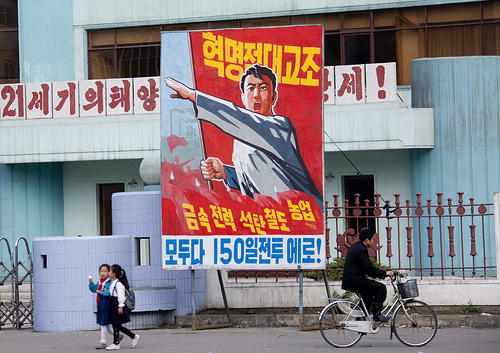
Photo by Eric Lafforgue
North Korean claims record production gains through ‘150-day battle’
Institute for Far Eastern Studies (IFES)
NK Brief No. 09-10-12-1
10/12/2009
It has been boasted that North Korea’s ‘150-day Battle’ to boost the economy (April 20-September 16) resulted in record-breaking jumps in DPRK production numbers, and it has been suggested that that by 2012, some enterprises will “attain production numbers higher than the best numbers recorded at the end of the 1980s.” This claim was made by Ji Young-il, the director of the Chosun University Social Science Research Institute, which is run by the pro-Pyongyang “General Federation of Korean Residents in Japan.”
In “Professor Ji Young-il’s Monthly Economic Review: The 150-day Battle and Prospects for Building an Economically Powerful Nation,” an article in the federation’s newspaper, Choson Sinbo, the author wrote, “There are more than a few enterprises that have set production goals for 2012 at more than three times the current level of production.” He also claimed that some enterprises in the mining, energy and railroad transportation sectors had set goals of as much as 6 times today’s production numbers.
Professor Ji went on to write, “Basically, it is an extraordinary goal ensuring growth of 1.3-1.5 times (a growth rate of 130-150%) per year.” He also explained that surpassing production rates as high as those seen in the late 1980s is one of the fundamental markers on the road toward “opening the door to a Strong and Prosperous Nation.”
Citing North Korea’s “Choson Central Yearbook,” he gave production numbers in various sectors of the DPRK economy at the end of the 1980s: electricity, 55.5 billion kWh (1989); coal, 85 million tons (1989); steel, 7.4 million tons (1987); cement, 13.5 million tons (1989); chemical fertilizer, 5.6 million tons (1989); textiles, 870 million meters (1989); grain, 10 million tons (1987).
Director Ji claimed that during the recent ‘battle’, production in the metals industries was up several times that of the same period in previous years, while energy producers generated several hundred million kWh of electricity, coal production was up 150%, and cement and other construction materials were up 140%. He pointed out that in 14 years of the Chollima movement, beginning in 1957, during which socialist industrialization took place in the North, the yearly average production growth was 19.1%, and he stated that the annual growth of 9 to 10% in industrial production over the past several years was a noteworthy record.
Moving to the agricultural sector, Director Ji also noted that while overseas experts have critiqued this year’s harvest, there has been a definite breakthrough in grain production with land cultivation hitting previously unseen levels over the past several years.
Previous 150-day battle stories below:
(more…)

